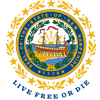Federal NPDES Permits
Required permits for certain municipalities.
The Federal Water Quality Act of 1987 recognized that runoff from urban areas and industrial sites pollutes surface waters. To address these stormwater discharges, the U.S. Environmental Protection Agency (EPA) created National Pollutant Discharge Elimination System (NPDES) permits using a two-phased approach. The Phase I and Phase II regulations were published in 1990 and 1999, respectively.
In Phase I, EPA requires “large and medium municipal separate storm sewer system” (MS4) operators to obtain permit coverage. These MS4s, none of which are located in New Hampshire, generally serve areas with populations of 100,000 or more. Dischargers of “stormwater associated with industrial activity” are also required to apply for permits.
The Phase I industrial sources, which are described in detail in 40CFR122.26(b)(14) generally include heavy and light manufacturing facilities, hazardous/solid waste processing, recycling facilities, transfer stations, junkyards, mining (including sand and gravel), timber processing, power plants, vehicle maintenance, marinas, sewage/sludge treatment plants and construction activities that disturb more than 5 acres.
Phase II regulates “small municipal separate storm sewer system” or “small MS4” discharges in urbanized areas; “stormwater discharge associated with small construction activity”; and municipally owned “Stormwater discharges associated with industrial activity” that were exempted from regulation during Phase I.



